Cultural tactics for TYLCV management
Reflective metallic mulch is shown to reduce the incidence of pest species including whiteflies (Csizinszky et al. 1999, Nyoike et al. 2008, Simmons et al. 2010). Reflective mulch is known to interfere with insects landing on tomato plants and subsequently reduce the spread of whitefly- transmitted viruses. There are also several drawbacks associated with the usage of reflective mulch. It is more expensive than standard mulches such as black and white plastic mulch. So far, the there is no reliable data available to clearly indicate that using reflective mulch can reduce the incidence of TYLCV and the extra cost associated with using reflective mulch is not justifiable. As a result growers have not been overwhelmingly adopting this tactic. Besides, the metallic reflective mulch is not biodegradable and its disposal is an environmental concern.
Despite the availability of these management tactics, TYLCV incidence is a constant threat to tomato growers in the southeast. The main reason for the current situation is the lack of a crop- free period. The utility of a crop-free period for the regional management of TYLCV is best illustrated by the approach taken in the Dominican Republic after severe losses peaked in 1993 (Alvarez and Abud-Atun 1995, Polston et al. 1999). Prior to implementing a crop free period crop losses to TYLCV were routinely high and growers had greatly reduced the length of theirproduction season since a large portion of the season had become unprofitable due to TYLCV- induced yield losses. Commercial tomato production in Dominican Republic is now possible only after implementation of crop free period. A similar approach is warranted in the Southeast.
The other reasons include shipping of virus-infected seedlings, and inadequate adoption of effective management options. Through this proposal we intend to provide growers convincing evidence as to how these factors can significantly impact TYLCV incidence and also provide them with enough TYLCV risk reduction tools. This effort would promote growers to adopt effective management tactics in an area-wide stature and ensure sustainability of tomato production in the southeast.
a. Mulch
Reflective (Silver) and white plastic mulch were evaluated as part of the split plot design along with TYLCV resistant cultivars and insecticides. Whitefly counts (adults and immatures), TYLCV-incidence, TYLCV severity, and yields were evaluated as explained under the resistant cultivars’ section. Some of the results are included below.
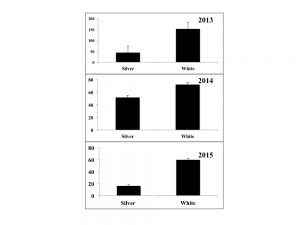
Fig. 1. Average counts of whitefly adults on 30 tomato leaves over the sampling period under silver and white mulch situations in 2013, 2014, and 2015 fall season in Georgia.
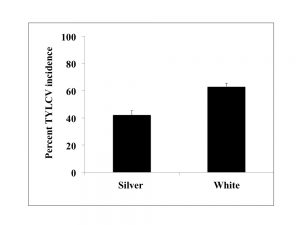
Fig. 2. AverageTYLCV incidence under silver and white mulch situations, observations were taken a few weeks before harvest (2014).
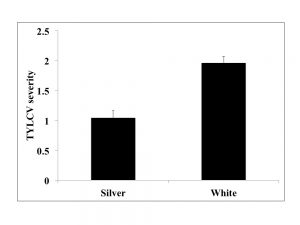
Fig. 3. AverageTYLCV severity rating under silver and white mulch situations, observations were taken a few weeks before harvest (2014).
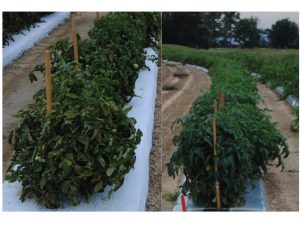
Fig. 4. Tomato cultivars grown under white (left) and silver mulch (right) conditions. TYLCV symptoms appear more prominent on the left than on the right.
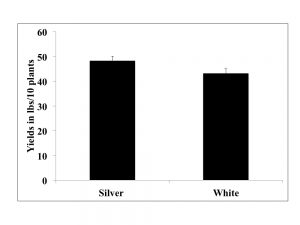
Fig. 5. Tomato yields under white (left) and silver mulch (right) conditions.
Results reiterate that using silver mulch decreases whiteflies settling on tomato plants as well as their growth, suppresses TYLCV incidence and severity; at the same time, modest yield boosts were also noticed. These results suggest that in the absence of silver bullets additive benefits based on management choices made could become very useful.
b. Seedlings as inoculum sources
Seedling trays from several growers were brought in to the greenhouse, sprayed with an insecticide, and TYLCV symptoms were monitored for 3 weeks. Symptomatic plants were extremely rare under these situations. Random PCR testing also did not indicate substantial TYLCV infections in these trays.
c. Inoculum sources in the vicinity
Trials were conducted with and without inoculum sources with indeterminate tomato as inoculum sources. Results indicated that the presence of TYLCV inoculum sources in the near vicinity (adjacent rows) did not influence the TYLCV infection outcome when compared with the absence of inoculum sources in the near vicinity. These outcomes indicated that whiteflies immigrating not from the immediate vicinity could be viruliferous as well, and that they could transmit TYLCV efficiently. These results suggest that crop free periods could be more effective than lack of inoculum sources in the near vicinity to suppress TYLCV incidence.
d. Non-crop inoculum sources
Results indicated that besides other known solanaceous crop hosts, weeds in tomato production systems were identified as alternate hosts. The role of such hosts as incoulum sources and their impact on TYLCV epidemics is being investigated.